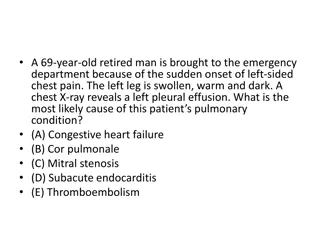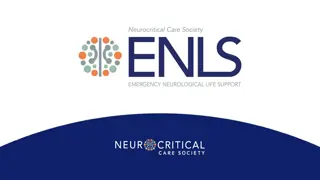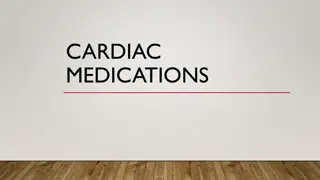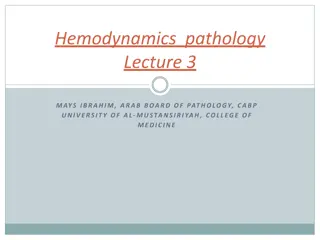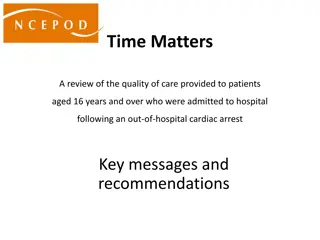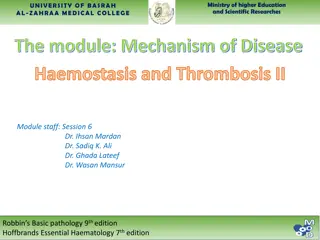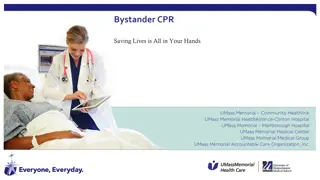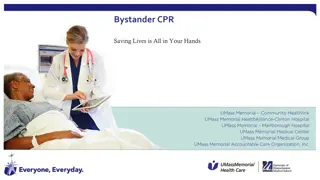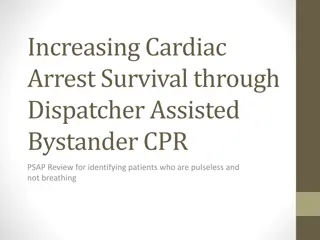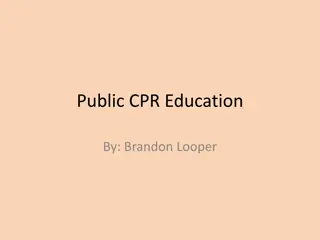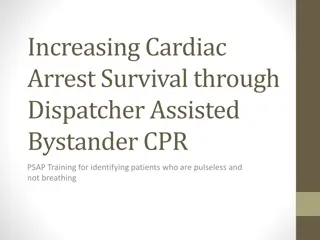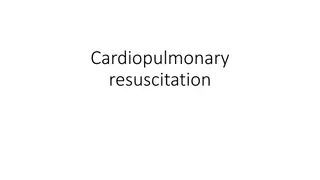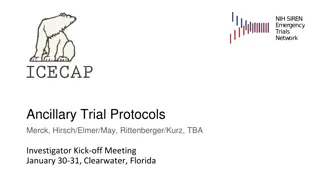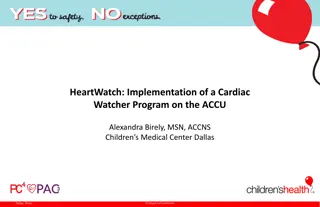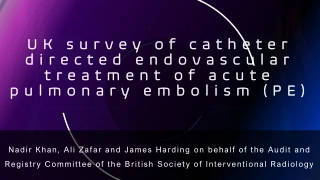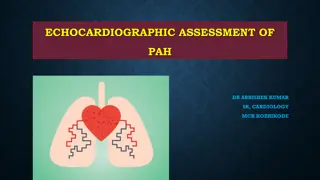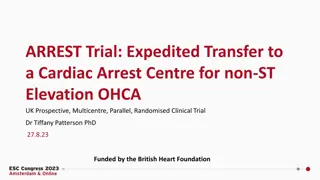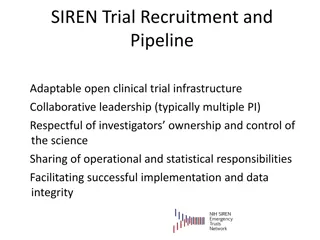Thrombolytics in Cardiac Arrest from Pulmonary Embolism: Evidence Review
Thrombolytics are suggested for cardiac arrest from presumed PE despite lack of RCTs focusing on this subset. Studies on undifferentiated cardiac arrest did not show a survival benefit. Trials using tissue plasminogen activator in PEA arrest showed no significant difference in outcomes, while a study on tenecteplase during out-of-hospital cardiac arrest was discontinued due to low survival rates. Overall, evidence for thrombolytics in PE-related cardiac arrest remains inconclusive.
Download Presentation

Please find below an Image/Link to download the presentation.
The content on the website is provided AS IS for your information and personal use only. It may not be sold, licensed, or shared on other websites without obtaining consent from the author. Download presentation by click this link. If you encounter any issues during the download, it is possible that the publisher has removed the file from their server.
E N D
Presentation Transcript
Deep Dive: The Evidence Behind Thrombolytics in Cardiac Arrest from Pulmonary Embolism EMRA Critical Care Committee
Thrombolysis in Cardiac Arrest from PE While only about 4% of patients with pulmonary embolism (PE) present with hemodynamic instability or cardiac arrest (CA), evidence shows that up to 65% of massive PEs are fatal.7 Current Advanced Cardiovascular Life Support (ACLS) and American Heart Association (AHA) guidelines suggest thrombolytics should be considered for cardiac arrest due to presumed PE. There have been no randomized control trials (RCTs) that have studied administration of thrombolytics in cardiac arrest due to PE. The only RCTs that added information involved administering thrombolytics in undifferentiated cardiac arrest, and they did not show a survival benefit.
RCTs looking at thrombolytics in undifferentiated cardiac arrest (not specific to PE)
Tissue Plasminogen Activator in Cardiac Arrest with Pulseless Electrical Activity Abu-Laban RB, Christenson JM, Innes GD, et al. Tissue plasminogen activator in cardiac arrest with pulseless electrical activity. N Engl J Med. 2002;346(20):1522-1528. Objective: Evaluate the effect of tissue plasminogen activator (tPA) in undifferentiated Pulseless Electrical Activity (PEA) arrest. Results: Only one patient (in the tPA group) in the whole study survived to hospital discharge. There was no statistically significant difference in rate of return of spontaneous circulation (ROSC), length of hospital stay, and hemorrhage. Methods: Blinded RCT of 233 patients. Before enrollment, patients with >1 minute of PEA arrest unresponsive to initial therapy underwent: endotracheal intubation, ventilation with 100% oxygen, bolus of normal saline and 1mg of epinephrine IV, then randomized to 100mg of tPA or placebo in a double- blind fashion. Resuscitation was continued for at least 15 minutes. tPA (n=117) Placebo (n=116) Absolute difference (95% CI) P value ROSC 25 27 -1.9 (-12.6 to +8.8) 0.85 Median length of stay 0.4 0.5 -0.1 (-0.4 to +2.5) 0.62 Major hemorrhage 2 0 +1.7 (-1.7 to +6.4) 0.50 Minor hemorrhage 1 1 0 (-4.1 to +4.1) 0.62 Survival to discharge 1 0 +0.9 (-2.6 to +4.8) 0.99 Bottom line: In this study with limited statistical power, there was no evidence of a beneficial effect of fibrinolysis in patients with cardiac arrest and Pulseless Electrical Activity (PEA) arrest of unknown cause.
Thrombolysis during Resuscitation for Out-of-Hospital Cardiac Arrest B ttiger BW, Arntz HR, Chamberlain DA, et al. Thrombolysis during resuscitation for out-of-hospital cardiac arrest. N Engl J Med. 2008;359(25):2651-2662. Objective: Evaluate the effect of tenecteplase during out of hospital cardiac arrest (OHCA). Results: After blinded review of data from the first 443 patients, the data and safety monitoring board recommended discontinuation of enrollment of asystolic patients due to low survival. In a subsequent review after enrolling a total of 1050 patients, the study was discontinued due to futility. Methods: Randomized, double-blind placebo- controlled multicenter trial. Adult patients were randomly assigned to receive Tenecteplase or placebo during CPR and then CPR was continued for at least 30 minutes; no adjunctive antithrombotic therapy was used. Tenecteplase (n=525) Placebo (n=525) Relative risk (95% CI) P value The primary endpoint was 30-day survival; the secondary endpoints were hospital admission, ROSC, 24-hour survival, survival to hospital discharge, and neurologic outcome. 30-day survival 77 89 0.87 (0.65- 1.15) 0.36 Bottom line: When tenecteplase was used in undifferentiated out-of-hospital cardiac arrest, there was no difference in mortality. This RCT was stopped prematurely due to futility.
Evidence specific to cardiac arrest from presumed PE (none are RCTs)
PEA in pulmonary embolism treated with thrombolysis (from the PEAPETT study) Sharifi M, Berger J, Beeston P, et al. Pulseless electrical activity in pulmonary embolism treated with thrombolysis (from the "PEAPETT" study). Am J Emerg Med. 2016;34(10):1963-1967. Results: ROSC occurred in all but 1 patient. There was no minor or major bleeding. Of the 23 patients, only 2 died in the hospital and 20/23 were alive at 22 +/- 3 months of follow up. The echo parameters studied improved significantly within 48 hours (both parameters p<0.01). Objective: Evaluate the outcome of low-dose systemic thrombolysis with tPA in patients presenting with PEA due to PE. Methods: Single center cohort of 23 patients with PEA and CA due to confirmed massive PE. This cohort was followed prospectively for clinical and echocardiographic outcomes. All patients received 50mg of tPA IV push over 1 minute, subsequently started on heparin. Outcomes studied included ROSC, survival to hospital discharge, major and minor bleeding. They also looked at certain ultrasound parameters such as RV/LV ratio and pulmonary artery systolic pressure. RV/LV ratio PASP Admission 1.79 58.1 Within 48h 1.16 40.25 Bottom line: In this small single center cohort, 50mg of tPA rapidly given in PEA arrest due to confirmed massive PE prior to arrest was effective in obtaining ROSC and led to enhanced survival and reduction in pulmonary artery pressures.
Tissue Plasminogen Activator Use in Cardiac Arrest Secondary to Fulminant Pulmonary Embolism Yousuf T, Brinton T, Ahmed K, Iskander J, Woznicka D, Kramer J, Kopiec A, Chadaga AR, Ortiz K. Tissue Plasminogen Activator Use in Cardiac Arrest Secondary to Fulminant Pulmonary Embolism. J Clin Med Res. 2016 Mar;8(3):190-5. Objective: Evaluate survival to hospital discharge for patients who had in-hospital cardiac arrest (IHCA) from suspected or confirmed PE who received IV tPA vs no thrombolytics. Methods: Single center, retrospective review on 42 patients who had IHCAs previously diagnosed with PE via imaging (CTA or V/Q scan) or had signs of right heart strain on US. Patients either received 100mg IV alteplase (45%) or no thrombolytics (55%) based on provider preference. Results: There was no significant difference in survival to hospital discharge (primary endpoint) or in ROSC, major bleeding, or minor bleeding (secondary endpoints). IV Alteplase (n=19) No thrombolysis (n=23) P value ROSC 9 (47%) 11 (48%) 1.00 Survival to discharge 2 (11%) 2 (9%) 0.98 Bottom line: In this small retrospective chart review, authors found no significant difference in survival to hospital discharge, ROSC, or bleeding among patients with IHCA with confirmed or suspected pulmonary embolism who received IV tPA during cardiac arrest vs those who did not.
Characterization of Alteplase Therapy for Presumed or Confirmed Pulmonary Embolism During Cardiac Arrest Peppard SR, Parks AM, Zimmerman J. Characterization of alteplase therapy for presumed or confirmed pulmonary embolism during cardiac arrest. Am J Health Syst Pharm. 2018 Jun 15;75(12):870-875. doi: 10.2146/ajhp170450. Results: 46% of patients received bolus-only dosing strategy, and the most common dose was 50mg. Patients in the bolus-with-infusion group were more likely to survive CA compared with other dosing strategies, but no significant difference in survival to hospital discharge was found between the three groups. Objective: Describe the dosing and administration of alteplase in cardiac arrest due to suspected or confirmed PE. Methods: Retrospective, multi- center, cohort study of 35 patients which evaluated alteplase use characteristics in adults who received alteplase during PE- induced cardiac arrest. Bolus (n=16) Infusion (n=8) Bolus + infusion (n=11) ROSC 1 0 2 Survival CA 0 0 2 Survival to discharge 0 0 1 Bottom line: In this retrospective cohort study, there was no clear difference in survival to hospital discharge between alteplase dosing strategies. The most common alteplase dose for patients with presumed or confirmed PE during cardiac arrest was a single 50 mg bolus, though ideal dosing strategy cannot be identified from this article.
Evaluation of Rescue Thrombolysis in Cardiac Arrest Secondary to Suspected or Confirmed Pulmonary Embolism Summers K, Schultheis J, Raiff D, Dahhan T. Evaluation of Rescue Thrombolysis in Cardiac Arrest Secondary to Suspected or Confirmed Pulmonary Embolism. Ann Pharmacother. 2019 Jul;53(7):711-715. Results: Primary outcome was survival to hospital discharge. Secondary outcomes included ROSC and ICU/Hospital Length of Stay. Hospital length of stay was >10 days in all three patients who survived to discharge. Objective: Evaluate baseline survival rate of patients with cardiac arrest presumed or confirmed to be due to PE who received IV thrombolytics during resuscitation. Methods: Single center retrospective review of 22 patients who had IHCA (68%) or OHCA (32%) with clinical suspicion or confirmed PE by CT Angiography who received IV thrombolytics. The thrombolytic given was heterogenous and was mostly alteplase (both 100mg IV and 50mg IV doses) or less commonly tenecteplase 45mg IV. ROSC Survival to hospital discharge Thrombolytics given (n=22) 11 3 Bottom line: In this small single-center retrospective review, very few patients (14%) who had cardiac arrest due to suspected or confirmed pulmonary embolism and received thrombolytics survived to hospital discharge.
Emergency Thrombolysis During Cardiac Arrest due to Pulmonary Embolism: Our Experience Over 6 Years de Paz D, Diez J, Ariza F, Scarpetta DF, Quintero JA, Carvajal SM. Emergency Thrombolysis During Cardiac Arrest Due to Pulmonary Thromboembolism: Our Experience Over 6 Years. Open Access Emerg Med. 2021 Feb 22;13:67-73. Results: There was no statistically significant difference in ROSC between the two groups, nor in secondary outcomes (24 hour mortality, survival to hospital discharge, survival with neurologic outcome). Objective: Examine the effect of alteplase in patients with cardiac arrest secondary to PE. Methods: Retrospective, observational, single-center cohort of 16 patients with confirmed or highly suspected PE as cause of cardiac arrest who received CPR with or without emergency thrombolytic therapy using alteplase. Alteplase, n=8 (%) No thrombolytics, n=8 (%) P value ROSC 8 (100) 7 (87.5) 0.3 Death at 24h 2 (25) 4 (50) 0.3 Death at 30d 5 (62.5) 5 (62.5) 1.0 Bottom line: In this small observational study, there was no difference in ROSC or 24-hr survival rate in adults with cardiac arrest due to pulmonary embolism between the group that received thrombolysis vs the group that did not. Limited by unclear treatment group allocation which may be a source of bias.
Take-Home Points Few patients who suffer cardiac arrest from massive pulmonary embolism will survive to hospital discharge. There are a limited number of studies currently on use of thrombolytics for cardiac arrest due to pulmonary embolism, none of which are RCTs. From the evidence available, there is no clear mortality or functional outcome benefit to any IV thrombolytic in this patient population. Additionally, while alteplase is the most common thrombolytic, there is significant heterogeneity in the dosing strategies. It is important for the clinician to weigh the potential benefits of IV thrombolytics for each individual patient against the risk of rare but significant bleeding events. No strong conclusions can be made without further studies.
1. Abu-Laban RB, Christenson JM, Innes GD, et al. Tissue plasminogen activator in cardiac arrest with pulseless electrical activity. N Engl J Med. 2002;346(20):1522-1528. doi: 346/20/1522 [pii]. B ttiger BW, Arntz HR, Chamberlain DA, et al. Thrombolysis during resuscitation for out-of-hospital cardiac arrest. N Engl J Med. 2008;359(25):2651-2662. doi: 10.1056/NEJMoa070570 [doi]. de Paz D, Diez J, Ariza F, Scarpetta DF, Quintero JA, Carvajal SM. Emergency thrombolysis during cardiac arrest due to pulmonary thromboembolism: Our experience over 6 years. Open Access Emerg Med. 2021;13:67-73. doi: 10.2147/OAEM.S275767 [doi]. Dirican A, Ozkaya S, Atas AE, Ulu EK, Kitapci I, Ece F. Thrombolytic treatment (alteplase; rt-pa) in acute massive pulmonary embolism and cardiopulmonary arrest. Drug Des Devel Ther. 2014;8:759-763. doi: 10.2147/DDDT.S61679 [doi]. Igneri LA, Hammer JM. Systemic thrombolytic therapy for massive and submassive pulmonary embolism. J Pharm Pract. 2020;33(1):74-89. doi: 10.1177/0897190018767769 [doi]. Javaudin F, Lascarrou JB, Le Bastard Q, et al. Thrombolysis during resuscitation for out-of-hospital cardiac arrest caused by pulmonary embolism increases 30-day survival: Findings from the french national cardiac arrest registry. Chest. 2019;156(6):1167- 1175. doi: S0012-3692(19)31390-X [pii]. Logan JK, Pantle H, Huiras P, Bessman E, Bright L. Evidence-based diagnosis and thrombolytic treatment of cardiac arrest or periarrest due to suspected pulmonary embolism. Am J Emerg Med. 2014;32(7):789-796. doi: S0735-6757(14)00276-9 [pii]. Long B, Koyfman A. Current controversies in thrombolytic use in acute pulmonary embolism. J Emerg Med. 2016;51(1):37-44. doi: S0736-4679(16)00150-5 [pii]. Niwa A, Nakamura M, Harada N, Musha T. Observational investigation of thrombolysis with the tissue-type plasminogen activator monteplase for acute pulmonary embolism in japan. Circ J. 2012;76(10):2471-2480. doi: N/JST.JSTAGE/circj/CJ-12-0091 [pii]. Nobre C, Thomas B, Santos L, Tavares J. Prolonged chest compressions during cardiopulmonary resuscitation for in-hospital cardiac arrest due to acute pulmonary embolism. Tex Heart Inst J. 2015;42(2):136-138. doi: 10.14503/THIJ-14-4267 [doi]. Peppard SR, Parks AM, Zimmerman J. Characterization of alteplase therapy for presumed or confirmed pulmonary embolism during cardiac arrest. Am J Health Syst Pharm. 2018;75(12):870-875. doi: 10.2146/ajhp170450 [doi]. Peters NA, Paciullo CA. Alteplase for the treatment of pulmonary embolism: A review. Adv Emerg Nurs J. 2015;37(4):258-72; quiz E4. doi: 10.1097/TME.0000000000000082 [doi]. Sharifi M, Berger J, Beeston P, et al. Pulseless electrical activity in pulmonary embolism treated with thrombolysis (from the "PEAPETT" study). Am J Emerg Med. 2016;34(10):1963-1967. doi: S0735-6757(16)30351-5 [pii]. Summers K, Schultheis J, Raiff D, Dahhan T. Evaluation of rescue thrombolysis in cardiac arrest secondary to suspected or confirmed pulmonary embolism. Ann Pharmacother. 2019;53(7):711-715. doi: 10.1177/1060028019828423 [doi]. Yousuf T, Brinton T, Ahmed K, et al. Tissue plasminogen activator use in cardiac arrest secondary to fulminant pulmonary embolism. J Clin Med Res. 2016;8(3):190-195. doi: 10.14740/jocmr2452w [doi]. 2. 3. 4. 5. 6. 7. 8. 9. 10. 11. 12. 13. 14. 15.


